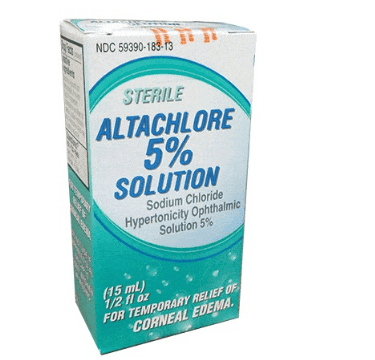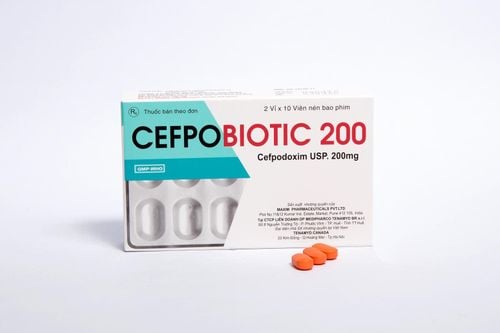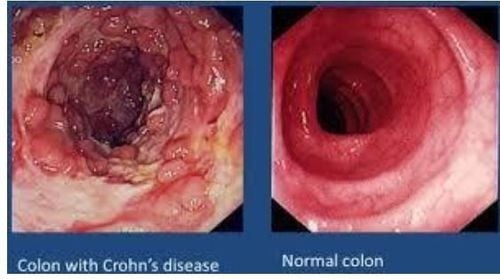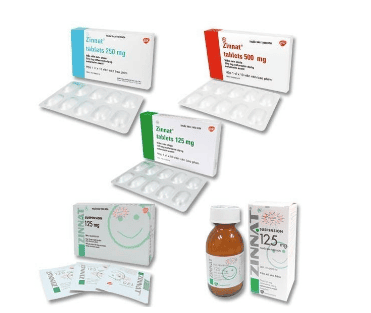This is an automatically translated article.
Abvaceff 200 is a product of US Pharma USA Co., Ltd., this is a 3rd generation Cephalosporin antibiotic used to treat bacterial infections in adults. To ensure the effectiveness of treatment and avoid unwanted side effects, patients need to strictly follow the instructions of the doctor, professional pharmacist.
What is Abvaceff 200mg?
Abvaceff 200 is a product of US Pharma USA Co., Ltd. The main ingredient is Cefpodoxime with a content of 200mg. Abvaceff 200 is an antibiotic indicated for the treatment of infections caused by susceptible strains of bacteria in adults. Abvaceff 200 is available as a film-coated tablet.
Cefpodoxime is a 3rd generation Cephalosporin antibiotic. In areas with low antibiotic resistance, Cefpodoxime is highly resistant to attack by beta-lactamases secreted by Gram-negative and Gram-positive bacteria. In principle, Cefpodoxime has a spectrum of activity against Gram-positive cocci such as pneumococci (Streptococcus pneumoniae), streptococcus (Streptococcus) groups A, B, C, G and Staphylococcus aureus, S. epidermidis with/ does not secrete beta-lactamase.
However, Cefpodoxime is not effective against isoxazolyl - penicillin-resistant staphylococci due to changes in Penicillin-binding protein (resistance is similar to methicillin-resistant Staphylococcus aureus - MRSA). The growing pattern of resistance to MRSA antibiotics is increasing in Vietnam.
Cefpodoxime is also active against Gram-negative cocci, Gram-positive and Gram-negative bacilli. Cefpodoxime is active against Gram-negative bacteria such as E. coli, Klebsiella, Proteus mirabilis and Citrobacter. However, in Vietnam, these bacteria are also resistant to 3rd generation Cephalosporins, which is a risk of treatment failure.
In contrast to other oral cephalosporins, Cefpodoxime is stable to beta-lactamases secreted by Haemophilus influenzae, Moraxella catarrhalis and Neisseria. However, to what extent the potency of cefpodoxime is superior to that of other oral cephalosporin antibiotics is unknown.
Cefpodoxime has little effect on Proteus vulgaris, Enterobacter, Serratia marcescens and Clostridium perfringens... sometimes completely resistant. Methicillin-resistant Staphylococcus aureus, Staphylococcus saprophyticus, Enterococcus, Pseudomonas aeruginosa, Pseudomonas spp., Clostridium difficile, Bacteroides fragilis, Listeria, Mycoplasma pneumoniae, Chlamydia and Legionella pneumophila are bacteria that are completely resistant to Cephalosporin antibiotics.
The bioavailability of cefpodoxime is approximately 50% if administered without food, however bioavailability is increased when cefpodoxime is taken with food. The serum half-life of Cefpodoxime is 2.1 - 2.8 hours in patients with normal renal function, in whom renal insufficiency has an increased serum half-life of up to 3.5 - 9.8 hours.
Uses of Abvaceff 200mg
Abvaceff 200 is indicated for the treatment of bacterial infections caused by susceptible strains in adults:
Upper respiratory tract infections: Acute bacterial sinusitis; Lower respiratory tract infection: Exacerbation of chronic bronchitis, bacterial pneumonia.
Dosage of Abvaceff 200mg
How to use: Take Abvaceff 200 as a whole, take Abvaceff 200 with food for optimal absorption. Dosage and time of taking Abvaceff 200 for each specific case will be different depending on the indications of the treating doctor.
Adults and adolescents with normal renal function:
Upper respiratory tract infections: acute bacterial sinusitis 200mg/time, 2 times daily. Lower respiratory tract infection: Acute exacerbation of chronic bronchitis 200mg/time, 2 times daily. Bacterial pneumonia: 200mg/time, 2 times daily. Elderly: There is no need to change the dose of Abvaceff 200 in elderly patients with normal renal function.
Children: The dosage form and dosage of Abvaceff 200 are not suitable.
Patients with hepatic impairment: Abvaceff 200 dosage does not need to be adjusted in case of liver failure.
Renal impairment: No dosage adjustment of cefpodoxime in Abvaceff 200 is required if the patient's creatinine clearance is greater than 40 ml/min:
Creatinine clearance (ml/min) 39 - 10: single dose of Abvaceff 200 per day 24 hours instead of 2 times a day (half the normal adult dose). Creatinine clearance (ml/min) <10: A single dose of Abvaceff 200 every 48 hours. Hemodialysis patients: a single dose of Abvaceff 200 after each dialysis session.
What are the side effects of Abvaceff 200mg?
When using Abvaceff 200, patients may experience undesirable effects (ADRs).
Common: Nausea/vomiting, diarrhea, abdominal pain, headache. Uncommon: Allergic reactions, rash, fever, arthralgia and anaphylaxis, erythema multiforme, liver enzyme disorders, hepatitis and transient cholestatic jaundice. Rare: eosinophilia, blood disorders, reversible interstitial nephritis, central nervous system hyperactivity, agitation, trouble sleeping, confusion, hypertonia, dizziness. Stop treatment with Cefpodoxime and inform your doctor of any unwanted effects encountered while using Abvaceff 200.
Contraindications Abvaceff 200Mg
Abvaceff 200 is contraindicated for use in the following cases:
Do not use cefpodoxime for patients allergic to Cephalosporins, hypersensitivity to any component of Abvaceff 200. Porphyrin metabolism disorders. Precautions when using Abvaceff 200:
Cefpodoxime is not the preferred antibiotic for staphylococcal pneumonia and should not be used in the treatment of atypical pneumonia caused by bacteria such as Legionella, Mycoplasma, Chlamydia. .. Cefpodoxime is not recommended for use in pneumonia caused by S. Pneumoniae. As with beta-lactam antibacterials, severe hypersensitivity reactions to Abvaceff 200 are sometimes fatal. In the event of a severe hypersensitivity reaction to Abvaceff 200, treatment should be discontinued immediately and appropriate measures taken. Therefore, caution should be exercised when Abvaceff 200 is used in patients with a history of non-serious hypersensitivity to other beta-lactams. Severe renal impairment requires dose reduction depending on the patient's creatinine clearance; Colitis and pseudomembranous colitis associated with oral antibiotics have been reported with nearly all antibiotics including cefpodoxime, ranging in severity from mild to life-threatening; Abvaceff 200 should be used with caution in patients with a history of gastrointestinal disease, especially inflammatory bowel disease; As with beta-lactam antibiotics, leukopenia and rarely agranulocytosis may develop, especially during prolonged Abvaceff 200 treatment. For cases of Abvaceff 200 treatment lasting more than 10 days, blood cell counts should be monitored and Abvaceff 200 treatment discontinued if leukopenia occurs. Cephalosporins can be absorbed onto the surface of red blood cell membranes and react with antibodies directed against the drug, thereby causing a positive Coombs reaction and, in rare cases, hemolytic anemia. Changes in renal function have been reported with cephalosporin antibiotics, especially when Abvaceff 200 is used concomitantly with potentially nephrotoxic drugs such as aminoglycosides, diuretics requiring close monitoring of renal function. . Prolonged use of Cefpodoxime may lead to overgrowth of non-susceptible organisms (Candida and Clostridium difficile); Abvaceff 200 products contain lactose excipients, Abvaceff 200 should not be used for people with galactose intolerance, Lapp - lactase deficiency, glucose - galactose malabsorption; Abvaceff 200 may cause dizziness, so caution should be exercised when using the drug for drivers, operating machinery. Abvaceff 200 for pregnant and lactating women There are no data on the use of cefpodoxime during pregnancy. However, cephalosporins are generally considered safe to use during pregnancy. Cefpodoxime passes into breast milk in low concentrations. Although the concentration is low, there are still 3 problems that will occur for breastfed children with Cefpodoxime: Disorders of intestinal microflora, the drug has a direct effect on the child's body, the result of bacterial culture will be If you need to do an antibiotic chart when the child has a fever.
Abvaceff 200 . drug interactions
H2 antihistamines and antacids reduce the bioavailability of cefpodoxime. Cefpodoxime bioavailability will be reduced by about 30% when co-administered with drugs that neutralize gastric pH or inhibit acid secretion, drugs such as antacids, H2 blockers should be taken 2-3 hours after taking Cefpodoxime; Probenecid reduces the excretion of Cephalosporins; Cephalosporins have the ability to increase the anticoagulant effect of Coumarin; Concomitant use of Cefpodoxime with Warfarin may increase the anticoagulant effect, it is necessary to monitor the INR regularly during and immediately after taking Cefpodoxime with an oral anticoagulant. Abvaceff 200 is a product of US Pharma USA Co., Ltd., this is a 3rd generation Cephalosporin antibiotic used to treat bacterial infections in adults. To ensure the effectiveness of treatment and avoid side effects, patients need to take the drug according to the prescription and consult a doctor, a specialist pharmacist.
Follow Vinmec International General Hospital website to get more health, nutrition and beauty information to protect the health of yourself and your loved ones in your family.
Please dial HOTLINE for more information or register for an appointment HERE. Download MyVinmec app to make appointments faster and to manage your bookings easily.













